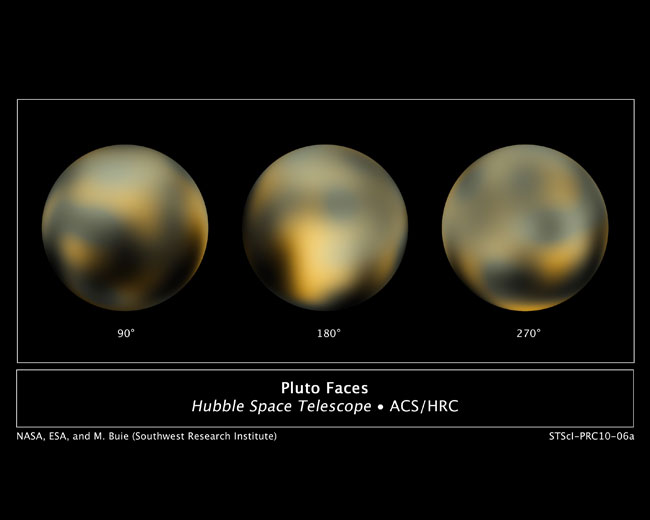
A NASA spacecraft speeding toward Pluto is casting a wary eye on the dwarf planet system, looking for anything that could trip it up in the home stretch of its historic mission.
NASA's New Horizons probe, which is set to perform the first-ever flyby of Pluto on July 14, has begun hunting for possible rings and undiscovered moons, in an effort to identify potential hazards near the dwarf planet. The campaign began Monday (May 11) and involves roughly weekly observations with the spacecraft's long-range camera through July 1, mission team members said.
"You know how Curiosity had its 'seven minutes of terror?'" said New Horizons principal investigator Alan Stern, of the Southwest Research Institute (SwRI) in Boulder, Colorado, referring to the NASA Mars rover's harrowing "sky crane" landing in August 2012. "Well, we call this 'seven weeks of suspense.'" [Photos of Pluto and Its Moons]
Small debris, big impact
New Horizons was the speediest spacecraft ever launched when it blasted off in January 2006, and it's now rocketing along at a healthy 32,570 mph (52,416 km/h) relative to the sun — so fast that a collision with a piece of debris just a few millimeters wide could prove fatal, even though the probe is protected by a Kevlar "bulletproof vest."
So the hazard-hunting team is on the lookout for any regions on or around New Horizons' path that may harbor such debris. That explains why the researchers are concerned about undiscovered moons.
"New moons might be shedding dust into the system, into a place where we can encounter it," said New Horizons science team member John Spencer, also of SwRI, who is leading the hazard search. The odds of actually slamming into a newfound moon are extremely small, he added.
Pluto is known to have five moons: Charon, Nix, Hydra, Kerberos and Styx. Charon, the innermost moon, was first spotted in 1978; at 648 miles (1,043 kilometers) in diameter, it's nearly half as wide as Pluto itself. The other four satellites are all tiny, and were discovered by NASA's Hubble Space Telescope between 2005 and 2012.
Get the Space.com Newsletter
Breaking space news, the latest updates on rocket launches, skywatching events and more!
Spencer said he wouldn't be surprised if New Horizons did indeed add some more names to this list.
"We know quite a lot of places where moons could be stable in the system," Spencer told Space.com. [New Horizons Spies Pluto's 5 Moons (Video)]
Several options

So what will the New Horizons team do if the current search turns up a possible hazard? There are two main options, which could be employed in tandem if need be.
One option is to point New Horizons' high-gain antenna forward, using it like a shield as the probe zooms through a debris field. But the spacecraft's handlers hope to avoid resorting to this strategy.
"That change would hurt our science significantly, because we wouldn't have the freedom to point in all the directions we'd like," Spencer said.
The other option is to change course. Mission team members have mapped out three alternate trajectories, two of which are merely slight adjustments to the nominal one, which takes New Horizons within 7,800 miles (12,500 km) of Pluto's surface. The third route would send New Horizons much closer to the dwarf planet, far inside Charon's orbit.
Shifting to either of the first two alternate trajectories would likely not impact the flyby's science return significantly, Spencer said. But the same is not true of the super-close route.
"If we fly that very close one, we cannot fly the nominal sequence," Spencer said. "We have to fly the sequence that has the antenna pointing forward, because things are just in too much of a different direction than they would be on the nominal sequence."
In addition, photos taken very close to Pluto would probably not be as sharp as those snapped from the nominal trajectory or the two similar alternates.
"Our cameras are designed to work from a certain distance, with things moving at a certain rate of speed through the system," Spencer said. "If you're speeding along a highway," he explained by way of analogy, "it's hard to read the sign on the front of a business that's right next to the road."
If mission team members decide to go with one of the alternate trajectories, New Horizons would likely perform an engine burn 14 days before the July 14 flyby. This maneuver would use little fuel, Spencer said, and probably wouldn't prevent New Horizons from visiting another object beyond Pluto in a potential extended mission (which NASA has not yet approved or funded).

Better safe than sorry
All of this being said, New Horizons' current trajectory appears to be quite safe, Stern and Spencer stressed.
"All the models say that the odds of losing the spacecraft due to a debris impact are far less than 1 percent," Stern told Space.com. "So, I really don't lose any sleep over it."
Still, he added, searching for hazards is the prudent thing to do, especially given the stakes involved: The $700 million New Horizons mission is about to return history's first up-close looks at Pluto, which has remained mysterious since its 1930 discovery.
And mounting such a mission to the outer solar system takes decades, so it's unclear when, if ever, the world would get a second chance at a Pluto first reconnaissance, Stern has said.
"This is a part of all exploration," Stern said of the potential hazards New Horizons faces in the Pluto system. "We're flying into the unknown."
Follow Mike Wall on Twitter @michaeldwall and Google+. Follow us @Spacedotcom, Facebook or Google+. Originally published on Space.com.
Join our Space Forums to keep talking space on the latest missions, night sky and more! And if you have a news tip, correction or comment, let us know at: community@space.com.

Michael Wall is a Senior Space Writer with Space.com and joined the team in 2010. He primarily covers exoplanets, spaceflight and military space, but has been known to dabble in the space art beat. His book about the search for alien life, "Out There," was published on Nov. 13, 2018. Before becoming a science writer, Michael worked as a herpetologist and wildlife biologist. He has a Ph.D. in evolutionary biology from the University of Sydney, Australia, a bachelor's degree from the University of Arizona, and a graduate certificate in science writing from the University of California, Santa Cruz. To find out what his latest project is, you can follow Michael on Twitter.
